Blogging A-Z
Labels: Blogging
The Blog of an English Catholic Priest
Labels: Blogging
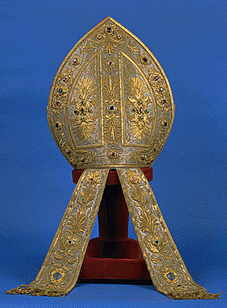
Valle Adurni has tagged me with the question: 'if the Holy Father were to nominate you bishop tomorrow (and anyone can play this one, lay, clerical, guy, gal,—this is about ecclesial priorities not ontology) what are (in order) the five (or more) really important issues that you would address first?'
Well, I thought of more than five and here they are, in no particular order:
An early and essential task would be to get to know your clergy and parishes – through a schedule of visitation and interviews with priests (perhaps deanery by deanery). That way, appointments could be based on personal knowledge. Once a week there would be an open slot so that priests could freely see the bishop and discuss problems, issues, etc.
If there was a seminary in the diocese, then that would be the apple of the new bishop’s eye. He would frequently visit, carefully appoint the staff (so that the right students reached Ordination) and not be afraid to make it a centre of spiritual and academic excellence.
The promotion of vocations would also be a priority and based on a pro-active approach, unashamedly setting forth the splendour of the Sacred Priesthood (including its many crosses – we are supposed to be ‘priest victims’ after all). Potential seminarians would not be rejected just because they were ‘too young’ or ‘too inexperienced’ or because their face didn’t fit – what’s the point of the six years of seminary if it can’t form men to be ‘other Christs’ in spite of their limitations?
The Cathedral and other key urban churches would be encouraged to become liturgical and musical centres. Guidelines would be produced so that parishes could correctly implement the new General Instruction. The Historic Churches Commission would make sure no needless architectural vandalism took place. The use of other rites and older editions of the Missale would, of course, be generously allowed.
A diocesan programme of catechetics would be drawn up, the emphasis being substance as well as style. A good catechists training centre would be established. The bishop would also visit his schools and make sure the Faith was being taught and lived there.
Bureaucracy would be cut back, where possible; the bishop would try to be more a shepherd than an administrator and committee meetings would be minimised!
Given the level of Catholic immigration, special attention would be given to ethnic chaplaincies and the integration of these groups into diocesan life. After all, most Catholics in this country are not English in origin and we owe to them the growth of the Church!
If a new Order or movement wanted to move into the diocese, the application would be encouraged and carefully considered.
To renew parochial life, such things as parish missions, novenas, processions, adoration and festal celebrations would be encouraged.
That should keep a new bishop pretty busy for the first few years!
Labels: Memes
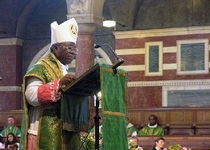 Cardinal Arinze was in town recently to inaugurate the Nigerian Catholic Chaplaincy (the national chaplain lives on the same floor as me) and to celebrate the Academic Mass at Westminster Cathedral (see the splendid photo above). In his homily he meditated on the meaning of faith:
Cardinal Arinze was in town recently to inaugurate the Nigerian Catholic Chaplaincy (the national chaplain lives on the same floor as me) and to celebrate the Academic Mass at Westminster Cathedral (see the splendid photo above). In his homily he meditated on the meaning of faith:My Catholic faith gives unity and meaning to my life. Otherwise the various things I do, or bear, or receive or hope for in life would be like scattered mosaics without a unified meaning. My daily duties would be one monotonous and dull detail after another, without connected meaning. I would be facing heat, cold, traffic jam, insistent telephone calls and endless office meetings which make every new day saluted with lack of enthusiasm, if not with a sense of boredom, meaninglessness and growing tiredness.
On the contrary, my Catholic faith is a dynamic and bright lantern for my path in life. It shows me Jesus as the way, the truth and the life (cf. Jn 14:6). It harmonizes my duties as a citizen and as a Christian (cf. Gaudium et Spes, 43). It excludes all divorce between my Sunday Mass and my duties on Monday to Saturday. My plans and hopes, my achievements and failures, my pains and aches as one grows older, and my joys and celebrations of milestones in life are all given a vital synthesis and sense of direction. I do not live with a pessimistic melancholy outlook on life. I have no temptations to suicide because such are often based on seeing no meaning in life. With St Paul I can humbly say that I know in whom I have believed and I have every reason to put my trust in Christ Jesus (cf. II Tim 1:12).
It is a risk to try to meet people of other religions if one does not have a clear idea of one’s Catholic identity and a calm insertion in it. A country does not send as its ambassador a citizen who cannot distinguish the flag of his country from two other flags, who has forgotten the name of the President or King/Queen of his country and of the Minister for Foreign Affairs, and who cannot sing the National Anthem!
A Catholic who is not well inserted in our Catholic faith and community is threatened by many dangers in the academic community. There is the error of secularism which lives or wants to conduct society as if God did not exist, as if religion were a private property which must not be allowed to show its face in public. There is religious or theological relativism which denies objective truth in any religion, which assumes the attitude that one religion is as good as another, and which is practically saying that your religion is true for you and my religion is true for me, as if sincerity were the only virtue and were the objective criterion of truth! Every teacher knows that sincerity is not enough, otherwise all students would pass the mathematics examination. Practical materialism can become equivalent to implicit or practical atheism when only material things are taken seriously and the existence of God is denied or ignored. The error of liberalism, which can sometimes approach indifferentism, is that of people who regard themselves as superior to all considerations of adherence to a definite religion or set of beliefs and who look on all religions with indifferent and benign compassion.
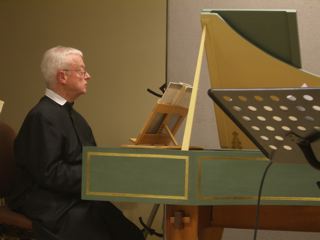
Very much in the spirit of St Philip Neri!
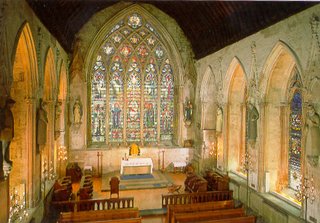
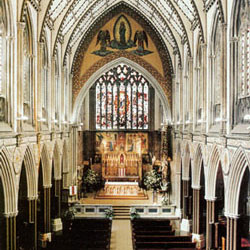
 There was time, also, to pop into the book launch of the latest offering from Family Publications: a reprint of John Gerard: The Autobiography of an Elizabethan, with a new introduction by Michael Hodgetts. It's a gripping story - as the write up says,
There was time, also, to pop into the book launch of the latest offering from Family Publications: a reprint of John Gerard: The Autobiography of an Elizabethan, with a new introduction by Michael Hodgetts. It's a gripping story - as the write up says,John Gerard was a Lancashire man, educated at Oxford and ordained in Rome. After a ministry in East Anglia he was arrested and tortured in the Tower of London but, miraculously, escaped and continued working as a priest for the next eight years, even gaining access to the courts of Elizabeth I and James I. After the Gunpowder Plot, however, he fled to the continent where he wrote this autobiography, which transports the reader into a world of priest-holes, secret Masses and high intrigue. He died in Rome in 1637 without ever seeing England again.Finally I rushed back to Kingsland where I was meeting some priest friends for Vespers and Benediction in preparation for the Feast of the Martyrs of the Venerable English College, Rome (1 December). Here is the scene in the sacristy afterwards:
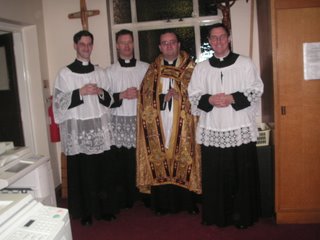 And the evening finished with a jolly meal on Newington Green. A great Catholic London day!
And the evening finished with a jolly meal on Newington Green. A great Catholic London day!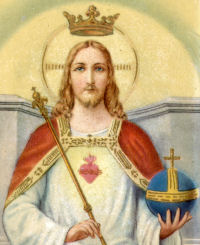
 The Institute now has a female branch, the Sisters Adorers of the Royal Heart of Jesus Christ Sovereign Priest. Here is a picture of five young ladies receiving the habit from the hands of the Bishop of Fiesole on 30 October this year:
The Institute now has a female branch, the Sisters Adorers of the Royal Heart of Jesus Christ Sovereign Priest. Here is a picture of five young ladies receiving the habit from the hands of the Bishop of Fiesole on 30 October this year: 
 And Cardinal Antonelli of Florence arriving in deep snow to celebrate the Feast of St Francis de Sales a few years ago:
And Cardinal Antonelli of Florence arriving in deep snow to celebrate the Feast of St Francis de Sales a few years ago:




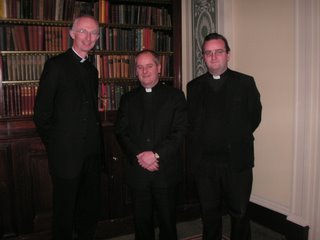 I was only able to stay for the inspiring address given by Mgr Ignacio Barreiro of Human Life International. Inspiring not because it contained anything new but because it was such a 'neat' synthesis of Catholicism and the problems facing it today. He stressed that in order to preach the 'Gospel of Life,' priests must make sure the totality of the Faith is preached. He recommended a systematic presentation of doctrine in our Sunday sermons rather than mere Scriptural exegesis, especially in Ordinary Time (or, as he put it, the 'Sundays after Pentecost'). I have often thought this although I wish someone more learned than I could put together such a doctrinal system for our three year cycle.
I was only able to stay for the inspiring address given by Mgr Ignacio Barreiro of Human Life International. Inspiring not because it contained anything new but because it was such a 'neat' synthesis of Catholicism and the problems facing it today. He stressed that in order to preach the 'Gospel of Life,' priests must make sure the totality of the Faith is preached. He recommended a systematic presentation of doctrine in our Sunday sermons rather than mere Scriptural exegesis, especially in Ordinary Time (or, as he put it, the 'Sundays after Pentecost'). I have often thought this although I wish someone more learned than I could put together such a doctrinal system for our three year cycle. Mgr Barreiro's talk will be made available soon - but in the meantime, as a sample of his writing, check out the sermon on the Blessed Karl of Austria here.
Mgr Barreiro's talk will be made available soon - but in the meantime, as a sample of his writing, check out the sermon on the Blessed Karl of Austria here.
Then I went to All Saints, London Colney, our diocesan centre on the outskirts of London. It's an impressive building - a former Anglican convent, boasting a chapel designed by Sir Ninian Comper:
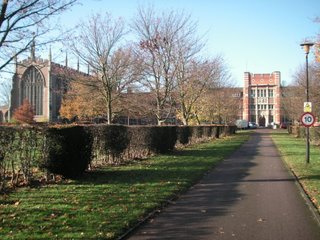 The occasion of my visit was the twice yearly 'Under 5s' meeting - for young clergy ordained within the last five years. Like most 'in-service' events I always slightly dread these conferences but normally end up enjoying them. The young priests of Westminster are a good bunch and we all get on well and have a largely similar outlook on the Church. As well as spending an enjoyable evening at the bar, we had a Holy Hour, a talk by Bishop George Stack (the Auxiliary who ordained me) and a session on time management and the things that obstruct us from being truly effective. Covering my hands in permanent marker ink, writing words on post-it labels and sticking them onto a board brought back very vividly the pastoral classes we sat through in seminary. In March the 'Under 5s' will spend some days at the Royal English College of St Alban in Valladolid, in the company of Cardinal Cormac and Bishop Alan Hopes, which should be fun...
The occasion of my visit was the twice yearly 'Under 5s' meeting - for young clergy ordained within the last five years. Like most 'in-service' events I always slightly dread these conferences but normally end up enjoying them. The young priests of Westminster are a good bunch and we all get on well and have a largely similar outlook on the Church. As well as spending an enjoyable evening at the bar, we had a Holy Hour, a talk by Bishop George Stack (the Auxiliary who ordained me) and a session on time management and the things that obstruct us from being truly effective. Covering my hands in permanent marker ink, writing words on post-it labels and sticking them onto a board brought back very vividly the pastoral classes we sat through in seminary. In March the 'Under 5s' will spend some days at the Royal English College of St Alban in Valladolid, in the company of Cardinal Cormac and Bishop Alan Hopes, which should be fun...
Labels: Diary, Priesthood
 My German friend, Jan, sent me the above photo from a German newspaper - though I'm not sure which one. I decided to scan it after a few unsuccessful google image searches. It shows the Holy Father enjoying a drink on the patio of his brother's house at Regensburg. It must be one of the first shots of a pope in a suburban domestic setting - and I think it's great!
My German friend, Jan, sent me the above photo from a German newspaper - though I'm not sure which one. I decided to scan it after a few unsuccessful google image searches. It shows the Holy Father enjoying a drink on the patio of his brother's house at Regensburg. It must be one of the first shots of a pope in a suburban domestic setting - and I think it's great!Labels: Papal
Before leaving for the start of the APGL Conference and then going on for an overnight stay at London Colney for some in-service training, let me just complete a meme suggested by the dúnadan. Here are the instructions:
1) Go to Wikipedia
2) In the search box, type your birth month and day but not the year.
3) List three events that happened on your birthday
4) List two important birthdays and one death
5) One holiday or observance (if any)
Right - my birthday (12 December) is the day of:
I hereby tag Fr Tim, Fr Sean and Joee Blogs.
Labels: Memes

Harrow is one of our finest public schools - founded in 1572 and boasting Churchill, Peel, Palmerston, Byron, Trollope and nineteen winners of the Victoria Cross as old boys. It has an impressive exhibition area, the Old Speech Room Gallery, and part of the Manning display can be seen in the picture above, including the mitre the Archbishop wore at Vatican I.
Dinner followed in the Senior Common Room, where our table had an ecumenical flavour - I had a very pleasant conversation with the Anglican chaplain and a representative of the Community of the Resurrection at Mirfield (founded by Bishop Gore).
We toasted Cardinal Manning, despite his celebrated teetotalism. His years at Harrow formed in him a regular prayer life, but there was little indication of Manning's future career. His greatest distinction at school was playing in the criclet eleven. During one inter-house match around 1823 two future archbishops (Manning and Trenchard of Dublin) and three bishops (Wordsworth, Oxenden and Terry) all played. Manning, we are told, also liked wearing tasselled Hessian top-boots!
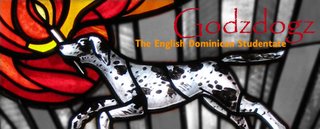
The name 'Dominican', although derived from the name of our holy father and Founder, St Dominic, is also a pun on the Latin phrase "Domini canes" which means 'Dogs of the Lord.'This was itself based on a dream which St Dominic's mother, Blessed Juana de Aza, had in 1170 when she was pregnant: she saw a black and white dog with a torch in its mouth setting the world ablaze. This was interpreted to refer to St Dominic and his spiritual children, the Dominican Order - in their black and white habits - whose preaching brings the light of Gospel truth to shine upon and inflame the world with divine love.And so, this site represents the 'barks' of this pack of 'God's dogs', hopefully gathering all into the flock of Jesus Christ, the Good Shepherd!
Labels: Blogging

 It's been a pretty busy week, especially since my PP has been away the last fortnight, leaving me 'in charge' of one of the largest parishes in this part of London. Luckily no major disasters - last time he went away part of the sacristy ceiling fell down!
It's been a pretty busy week, especially since my PP has been away the last fortnight, leaving me 'in charge' of one of the largest parishes in this part of London. Luckily no major disasters - last time he went away part of the sacristy ceiling fell down! Every year we celebrate the dedications of the four major basilicas of Rome. In August we commemorate St Mary Major, one of the most venerable Marian churches of the world. A short time ago we kept the dedication of the Basilica of St John Lateran, which is the Pope’s Cathedral and the mother church of Christendom.
Every year we celebrate the dedications of the four major basilicas of Rome. In August we commemorate St Mary Major, one of the most venerable Marian churches of the world. A short time ago we kept the dedication of the Basilica of St John Lateran, which is the Pope’s Cathedral and the mother church of Christendom. I love hunting for bargains and trawling the lists on e-bay. I've found a few treasures over the years but nothing quite in the league of the late Miss Preston of Oxford, who had two lost panels of Blessed Guido di Pietro (Fra Angelico) in her spare room. She had bought them for a mere £200 forty years ago and they were only identified shortly before her death. Read the full story here. I'm not sure which Dominican saints the panels show - presumably not St Albert the Great, whose feast we keep today, since he was only beatified in 1622 and canonised in 1931.
I love hunting for bargains and trawling the lists on e-bay. I've found a few treasures over the years but nothing quite in the league of the late Miss Preston of Oxford, who had two lost panels of Blessed Guido di Pietro (Fra Angelico) in her spare room. She had bought them for a mere £200 forty years ago and they were only identified shortly before her death. Read the full story here. I'm not sure which Dominican saints the panels show - presumably not St Albert the Great, whose feast we keep today, since he was only beatified in 1622 and canonised in 1931.  I've been asked to advertise the presentation of the English version of Martin Mosebach's book, Heresy of Formlessness, at 6.30pm in St Wilfrid's Hall (London Oratory) on 7 December.
I've been asked to advertise the presentation of the English version of Martin Mosebach's book, Heresy of Formlessness, at 6.30pm in St Wilfrid's Hall (London Oratory) on 7 December. The picture shows a group of WWI officers during training, including my grandfather, Henry Norman Schofield, who is in the middle with a baton under his arm.
The picture shows a group of WWI officers during training, including my grandfather, Henry Norman Schofield, who is in the middle with a baton under his arm.Labels: Sermons
4. Roman Miscellany, by Father Nicholas Schofield. This is my effort to be global. Father Schofield writes from London. I’m sure there are some good French and Italian priest bloggers, but the heck if I can read what they’re writing. As for English-speaking bloggers, the vast bulk of them come from the United States, but Schofield represents the other side of the pond well.Well, I've never had to represent my country before! The top three blogs are (in reverse order) What Does the Prayer Really Say?, Dappled Things and Catholic Ragemonkey.
Is it unbecoming for a priest to do something as mundane as blogging? I don’t think so. I think of their posts as printed homilies, just pithier. Besides, if Thomas Merton could take an oath of silence as a Trappist monk, then speak volumes (and volumes) through his books, why shouldn’t a priest be allowed a little platform?I think we can all say 'Amen' to that!
By the way, today the visitor numbers crossed the magic 20,000 mark. When I reluctantly started the blog in April I never thought I'd still be here in November - and I'm still not sure how long it will last - but thanks for your readership. And let's have some more British Catholic blogs - if I can do it, with my limited computer know-how, then anyone can!
Labels: Blogging
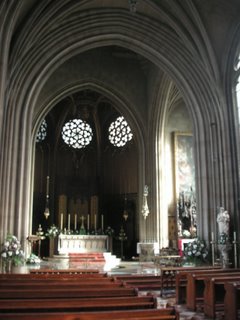
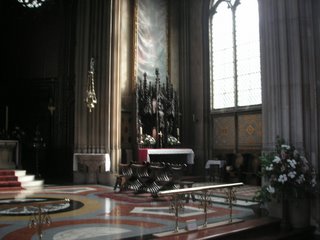 The grounds aren't huge but there are some fields (with pigs, cows, chickens, etc) and a lovely path which is ideal for a 'rosary walk':
The grounds aren't huge but there are some fields (with pigs, cows, chickens, etc) and a lovely path which is ideal for a 'rosary walk':

No pictures of newly blessed Abbot Cuthbert, I'm afraid (a pity since he managed to wear a different abbatial cross each day of the week, except Friday) but the Abbey is fully recommended for a convenient 'monastic retreat' on the doorstep of London.
Labels: Diary
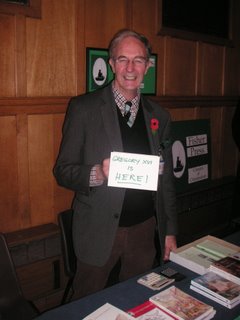
Here is Fr Whinder and Antony proudly displaying the new book: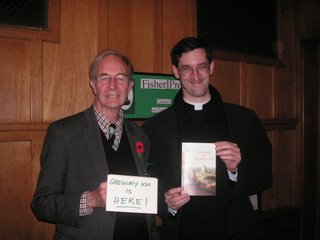
And, finally, a pastoral moment from Fr Whinder's book-signing session: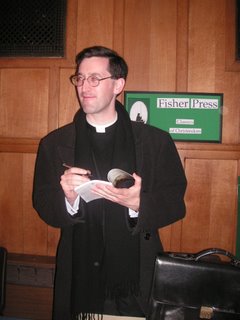
Fisher Press don't have a website (I think Gregory XVI would approve) but they can be contacted at PO Box 41, Sevenoaks, Kent TN15 6YN, UK. Wiseman's Gregory XVI is essential reading for the modern Catholic!
Labels: Books
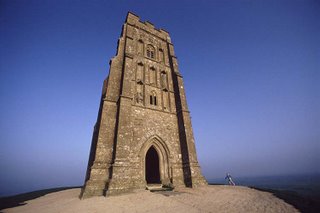
The article has a picture (sadly not online) of a Blessed Sacrament procession through the hallowed streets of Glastonbury, led by ex-gangster John Pridmore ringing a bell and several members of the Franciscan Friars of the Renewal. It's unfortunate that tempers were raised and that Catholics behaved so badly. However, I wouldn't dismiss as 'medieval' the attempt to put Christ back into Glastonbury by holding a Youth 2000 festival. After all, Glastonbury has so many associations with the saints - including SS Joseph of Arimathea, Patrick, Columba, David and Blessed Richard Whiting - and yet the town has been 'overtaken' by practitioners of a very alternative belief system. Surely Catholicism has an honoured place in modern Glastonbury?Bad vibes in Glastonbury after Catholics turn against pagans
by Ruth Gledhill, Religion Correspondent
BY THE light of the full moon, witches in Glastonbury will tonight be casting a “circle of protection” around Britain’s centre of mysticism after a group of militant Christians cast salt at them in an attempt to “cleanse” the town of paganism.One Roman Catholic was fined and two cautioned by police after the “alternative Hallowe’en” festival in Britain’s centre of magical mysticism turned into a spiritual battle between Christianity and paganism.
Now even the local Catholic priest has told his fellow Christians that they are not welcome in the town. The Christians were visiting for the Lightswitch@glastonbury festival, the eighth such event organised by the Catholic charity Youth 2000. Promotional material tempted them there with slogans such as: “Has the light on your halo gone dark? Have your wings gone a bit grubby? Just want to switch your faith back on?” Organised with the co-operation of the Catholic Parish Church and Shrine of Our Lady St Mary in Glastonbury, it was intended to be the Hallowe’en of choice “for those who have grown tired of tatty fancy dress and the Blair Witch Project”.
But police were called after militants told locals that they wanted to cleanse the town of paganism, cast salt around to exorcise “evil” spirits and called one woman a “whore witch”. Yemaya Pinder, a witch and a member of the Pagan Federation who owns The Magick Box store, said that she believed the Christians should be prosecuted for a religious hate crime. Mrs Pinder, a mother of two and grandmother of four, and whose sister is an Anglican vicar in Basildon, described how a group of Catholics had entered her shop and abused her. She said: “It was as if we had returned to the dark ages. They told me they wanted to cleanse Glastonbury of paganism. They said they had lighters and were going to come back and burn us down. When the police asked them to apologise, they refused.”
She said there were no plans to put a curse on the Christians. “But we are doing protection for ourselves and the shop and the town. We are working magic for the healing and the damage they very nearly did between us and the local Roman Catholic church.” She said that the town’s witches had begun to work their magic, starting the protective circle on Samhein, the Celtic new year, last Tuesday, and planning to finish it using the “high energy” of tonight’s full moon.
Dreow Bennett, the Archdruid of Glastonbury and leader of the pagan movement, said: “To call the behaviour of some of their members medieval would be an understatement. I witnessed a pagan being called a ‘bloody witch’ and being told, ‘You will burn in hell’. “Apparently this man was not a diligent follower of the teachings of Christ. It was my understanding that Christ taught compassion and tolerance rather than
hatred and ignorance.”Father Kevin Knox-Lecky, the Catholic parish priest at Glastonbury, said: “I was utterly appalled by the disgraceful behaviour, language and threats that were apparently made to members of the local pagan community by a small fringe group that attached itself to the Youth 2000 retreat last weekend in Glastonbury.” He said the militants were “unChristian and unrepresentative” of the majority of the 350 young people at the festival. He had since met Mrs Pinder and Mr Bennett. The conversation ended in “mutual embrace”. He said: “We have agreed to keep in touch with each other and to support each other in the event of negative attention from any extremists from whichever faith. I have frequently found evidence of rites performed on my church steps.”
Youth 2000 is a registered charity which aims to forge links
between young Catholics through retreats and events. Charlie Connor, the managing director of Youth 2000, said that aiming “blessed salt” at pagans was in direct contravention of the spirit of Youth 2000. “For the avoidance of doubt, Youth 2000 does not condone or encourage this kind of behaviour from anyone. We fully agree that differences on matters of faith cannot and should not be resolved by any kind of harassment.” But he added: “Youth 2000 would also like to place on the record that many young people at the retreat were harassed, sworn at and even cursed by people. One incident included the taking of photographs of young people, including children, and numbers plates by people present in the town. They were forced to move on. Regrettably, Youth 2000 will not be running a festival in Glastonbury next year.”Avon and Somerset police said: “The neighbourhood beat manager was on patrol on Saturday and was alerted that there was an incident at the Magick Box shop. The officer arrested a man for a public order offence. He was later released after being issued with a fixed penalty notice. Two women were also given cautions and words of advice about their future behaviour.”
Labels: News
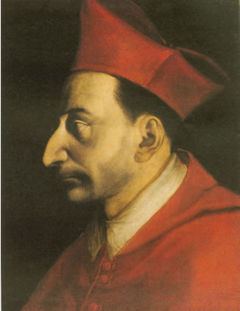

Labels: Diary


Well, actually we started the tradition of a Latin Mass Society pilgrimage last year, but it's great to see photos of High Mass in the church of my diaconal and priestly ordinations! I think it's one of London's hidden gems, especially since it is completely 'intact.'
A large doff of the biretta to Joee Blogs (check out his post for many more splendid photos) and also to the photographer, Mr Gregory Flash, who I'm sure won't mind me using these photos here.
Labels: Liturgy
 Today, priests have the privilege (though not the obligation) of celebrating three Masses. The only other day that you can do this is Christmas - although, of course, by way of exception most priests will say three Masses (or even more) on a Sunday.
Today, priests have the privilege (though not the obligation) of celebrating three Masses. The only other day that you can do this is Christmas - although, of course, by way of exception most priests will say three Masses (or even more) on a Sunday.Labels: Archives

A Short Homily for All Saints
Throughout the year we celebrate the feasts of the saints. Some will have universal significance – the first Apostles, the hosts of martyrs, the great Popes and Bishops, the learned Doctors of the Church; others will have a more local significance – England and Wales has a national calendar and Westminster a diocesan one, so we celebrate the likes of St Alban (our first martyr), St Edward (King and founder of Westminster Abbey) and the English Martyrs.
The thing that always strikes me most about the saints is their sheer number and variety. When I go abroad I love to learn about the local saints. I spent a fortnight in Italy this summer and visited the shrine of San Pellegrino (an Irish hermit who lived in the Appenines), which is located in a mountain-top village some 4,000 feet above sea level. I also had the privilege of saying Mass over the tomb of my patron, St Nicholas, which can be found in the southern Italian city of Bari. In the world of the saints, there is something for everybody. That’s why we all have our favourites.
So, today we celebrate all the saints officially recognised by the Church – the famous ones as well as the more obscure ones. But this is only part of the mystery that we celebrate on the Feast of All Saints. We also commemorate - perhaps, it could be said, we especially commemorate – the many saints in Heaven whose names we do not know.
In the first reading, St John describes his vision of ‘a huge number, impossible to count, of people from every nation, race, tribe and language’ standing in front of the Lamb, ‘dressed in white robes and holding palms in their hands.’ The white robes and palms stand for victory over sin and triumph over death. These are the blessed ones who have lived holy lives – the poor in spirit, the gentle, the merciful, the peacemakers, the persecuted – those who have lived out the Beatitudes in their daily lives and can now rejoice in the glory of Heaven. They include men and women from every age, background and race; they include, please God, members of our own family and people we have known. We honour them today and ask them for their assistance.
There’s a more personal dimension to our Feast as well. One day, we hope to be fellow-citizens of the Kingdom of Heaven, to take our place amidst the assembly of apostles, the host of martyrs and the college of confessors. The Church on earth is one of sinners trying, yearning, fighting to become saints. The witness of thousands of our brothers and sisters show us that anything is possible with the grace of God – many of the great saints (like St Augustine or St Mary Magdalene) had been great sinners. Saints are not just dead people with strange names and long beards who populate stained glass windows – they are our friends and our exemplars. They are real people who struggled with the sort of very real problems and temptations that we face, even if they wore funny clothes. Their lives show the transforming power of God’s grace.
Sanctity is within our grasp!